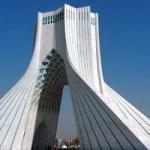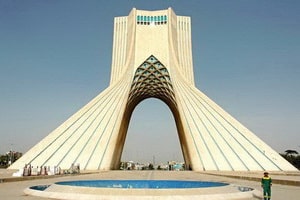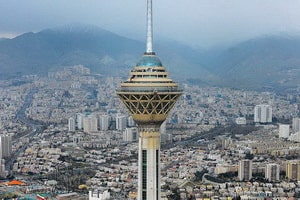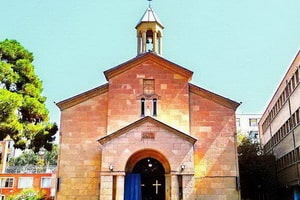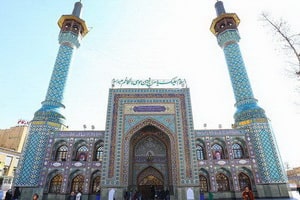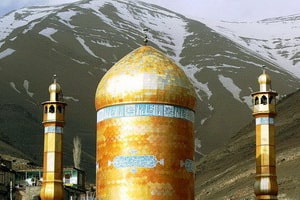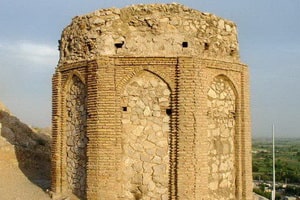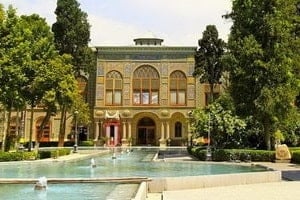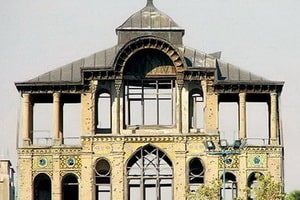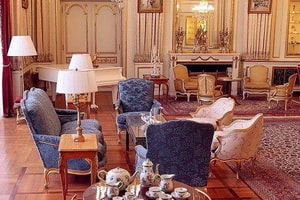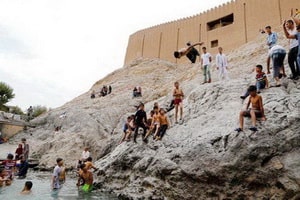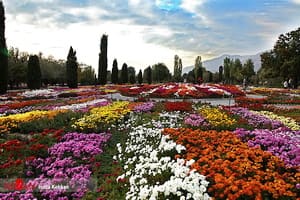
Geographic context
The Tehran region is located in the central-southern part of the Elburz mountain range (Persian: Alborz), which extends in the north of Iran, from west to east, from Azerbayjan to Khorasan. The Elburz mountain range is divided into 3 slopes:
Northern escarpment: the heights of this escarpment are found in the regions of Teheran and Mazandaran.
Central / Middle slope: forms the northern limit of the region and is the highest part of the Elburz mountain range. In this section is the Damavand mountain whose summit reaches the 5671 meters. The peak of Damavand is the ninth in the world for its height. This imposing escarpment continues in the form of the Kandovan mountains and the Taleghan mountains in the northwest of the region up to the junction of the Alamut river to the Taleghan-rud river. This slope also continues in the north-east of the region with the name of the chain of the heights of Firuze-kuh and Savad-kuh up to the valley of the river Firuze-kuh (main tributary of the Hableh-rud) that crosses the southern part of its eastern slope . To the east of the Firuze-Kuh river valley, which after the receipt of some tributaries takes the name of Hableh-rud, begin the heights of Shahmirzad.
Southern escarpment: it is the third section of the central reliefs, cut by the rivers Jajrud and Karaj that divide it into three parts separated from each other. These three parts include:
- the Lavasanat mountains which lie between the valleys of the Damavand and Jajrud rivers and are bounded to the north by the Lar river valley.
- the continuation of these mountains east of the Ab-e Ali road with the name of Ghara Dagh and Damavand up to the valley of Hableh-rud.
- the Shemiranat mountains which lie between the sources of the Jajrud and Karaj rivers. Their highest point is the Tochal peak with 3942 meters.
Besides these three mountain slopes there are mountains of lower altitude in the south and east of the Teheran plain. The most important are the Hossein Abad and Namak mountains to the south, Bibi Sharbanu and Alghader to the southeast and the heights of Gasr-e Firuze to the east.
Tehran is one of the provinces of the homonymous region and is located in the north of Iran on the southern side of the Elburz mountains. The province is bounded to the north by the province of Shemiranat and the Elborz region, to the east by the province of Damavand, to the south by the provinces of Varamin, Rey and Eslamshahr, to the west by the provinces of Qods, Shahryar and the Elborz province.
Tehran is located in the mountainous area with a moderate climate and in the semi-desert plain. Tehran is located on the border between continental and oceanic climatic conditions, but tends more towards continental ones.
The existence of perennial rivers such as the river Karaj, the river Jajrud, Rud-Lar, Hableh-rud, Rud-e Shur or Abhar-rud and Taleghan-rud, mean that the region of Tehran never lacks water sources . Most of the rivers in the region have their source in the Elborz Mountains. In the region there are numerous qanat (underground channels) that in the past not so far guaranteed the necessary water to the city areas and the countryside in an appropriate manner. Today, with the use of pipelines that carry water from large dams such as the Amir Kabir, Latyan and Rud-Lar dams, the water of the qanat and springs is used only for agriculture and irrigation. Only some sources, particularly those of mineral water, which are concentrated mostly in the north-east of the region, have retained their importance. The most important of these sources include: Cheshme-ye A'la-ye Damavand, Cheshme-ye Ghale-ye Dokhtar, Cheshme-ye Ab-Ali-ye Haraz, Cheshm-e ye Valeh at Ghachsar, Cheshme-ye Shah-dast near Karaj, Cheshm-e Ali in the city of Rey, Cheshme-ye Tizab, etc.
Climate:
In the different areas of the Tehran region, due to the particular geographical situation, there are different climates. Three geographical factors play an influential role in determining the region's climate:
- the salty desert:
dry areas such as the Ghazvin plain, the salty desert of Ghom and the dry areas of the Semnan region which are adjacent to the Tehran region are among the negative factors that influence the climate and cause heat and dryness of the air and lead to dust and dust.
- the chain of the Elburz mountains:
this mountain chain is a factor in climate adjustment.
- wet winds and westerly precipitation:
these winds play an influential role in moderating the burning heat of the desert area, without however neutralizing it.
The Tehran region can be divided into the following three climate sections:
- climatic region of the northern reliefs: it is located on the southern slope of the peaks of central Elborz at an altitude above 3000 meters and has a humid and semi-humid and cold climate with long and very harsh winters. The most noticeable points of this climatic region are Damavand and Tochal.
- foothill climatic region: this climatic region extends between 2000 and 1000 meters above sea level and has a semi-humid and cold climate and relatively long winters. Ab-e Ali, Firuze-kuh, Damavand, Galandvak, Sadd-e Amir Kabir and the Taleghan valley are located in this climatic region.
- semi-dry and dry climatic region: with short winters and hot summers it is located at an altitude of less than 1000 meters, and the more the altitude decreases, the more dry the environment increases. Varamin, Shahryar and the southern part of Karaj province are located in this climatic region.
History and Culture
The region of Tehran with 18 909 km2 of surface, 1,2% of the total surface of Iran, is different from the other regions of the country in that it is the political center of the Islamic Republic of Iran.
Tehran, the capital of Iran, is the most populous city in the country and from the point of view of the urbanized surface it is among the largest cities in the world.
The Tehran region, which extends in the northwestern part of the central plateau of Iran, was inhabited since prehistoric times and traces of prehistoric cultures can be traced here and there.
The excavations and analyzes of archaeologists from one hundred years to today have recognized and revealed many of the cultural centers in the Teheran plain and this shows that this plain was inhabited at least from the second half of the second millennium BC. C. (iron age).
At the time of the Sassanids, the Zoroastrian religion was common to Rey and some large fire temples were built north and south of Tehran. The first Ghasran temple of fire was located at 30 km from the center of Tehran in front of one of the mountains of Mount Tochal.
In the dictionary of Anandraj it reads "The city of Tehran was built in the southern part of the current Tehran and was made of humble houses similar to caves but gradually developed from the north approaching the source of the ghanat (underground channels) where the houses were built" . In the book "Teheran at the time of Nasser" it is written to you: "before the twelfth century Teheran was one of the unimportant villages and the city of Rey which was about 6 km away was considered the great center of civilization and culture ancient of this region, until the destructive assault of the Mongols, the internal wars, the religious conflicts, the divisions between the various sects brought Rey to ruin ". In the book "The wonders of the city" we read: "Teheran is a village in the circumscription of Rey, with many gardens with trees and good and abundant fruits and the inhabitants live in underground dwellings".
Until the onslaught of the Mongols, Tehran remained a village not much esteemed and like the other villages of the circumscription of Rey it was administered by the rulers of Choresmia. Yaqut Hamawi, a great Arab explorer, when he fled from the Mongols in the year 1220, mentioned this village.
After the recurrent earthquakes that struck Rey and other Mongol assaults, Teheran gradually abandoned the village aspect and turned into a small town with 4 emamzade and some sacred buildings. Among Tehran's first emamzade we must remember the emams of Zeyd, Yahya, Esmail and Seyed Nasseroddin.
In this period the agriculture and the cultivation of the gardens developed and this attracted the gaze of the invaders and the inhabitants of the countryside around Tehran. This situation lasted until the end of the Turcoman period and at the beginning of the savafide.
The historical region of Rey, due to its particular geographical situation, was a meeting place for different philosophies, beliefs and religious beliefs; in fact, finding itself along the silk road that connected the world known at that time from the Far East to the extreme Occident, it was crossed by every kind of religiosity. The traces of ancient times found in Rey and in the metropolitan area of the current Tehran, as well as the writings of historians, show that the Mazdean and Zoroastrian beliefs and customs were common among the inhabitants of the region. Many Jews lived in Rey for social and economic reasons and also because the city was along the Silk Road and had their own synagogues and neighborhoods and shops. In the same way there are signs of the presence of Christians in the region, probably Nestorians. With the advent of Islam and the taking of Rey in the year 642, the local people gradually moved towards Muslim religiosity. From the beginning, various confessions appeared within Islam, and even in this region, Shiites and Sunnis lived side by side.
The human appropriations that have existed in the area of Teheran since antiquity, show traces of the settlement and the appearance of civilization in this region. Among them "Cheshme-ye Ali" at Rey, which dates back to 6200 years ago, is particularly important. Human groups living more than 6000 years ago in this area are considered among the first indigenous tribes and ethnic groups in the region. The civilization that through these tribes was born and developed at Cheshme-ye Ali was very powerful and, little by little, could exert its influence on other tribes outside its own area, such as those who lived in Tappe-ye Syalk, Ghara Stages (Shahryar), Mushlan Stages (Esmail Abad), Tappe-ye Hesar (Damghan), Teppe-ye Anu and in Torkestan and eastern Iran up to Baluchestan. This group is considered among the first and original groups of the Teheran region that subsequently spread in different forms to Tappe-ye Darrus, Gheytarie and in many places in the region.
Since the city of Tehran was chosen in the 1786 as the capital of Iran by Agha Mohamad Khan Qajar until today, the city has experienced countless events.
The tongue
The main language of the people of Tehran and its region is Persian. But in some places they also speak of local languages that are generally considered Persian dialects. Other languages and dialects such as the Azeri, the gilaki, the lori, the mazandarani have been added because of immigration.
Traditional music
This region is the center of every cultural expression of Iran and in particular the city of Tehran which is the seat of government. Today, the Tehran region is the center of the dissemination and dissemination of Persian music, both of the traditional classical genre (Maqami) and its more modern expressions. Each of the ethnics that emigrated to this area, brought their own culture and musical tradition, and for this reason in the different locations of the Tehran region you can find many kinds of regional music, including that of Azari, Kurdish, lori, gilaki, khorasani, sistani and bandari. The representation of Taziye (the popular commemoration of the martyrdom of Emam Hosein), with its choral singing and music, is the most important and ancient expression of the traditional musical of the inhabitants of Tehran, takes place in the Moharram and Safar Arab months of each year in several locations and is very much involved. Also other modern artistic and theatrical representations are staged every day in the great theaters of Tehran, cheering the spirits of tourists and city dwellers.
Local cuisine
The local dishes of the Tehran region are: different types of Kabab - including Shami Kabab, Chelo Kabab, Kabab-and Hoseini and lamb Kabab - meat broth, Kufte (meatballs), various types of soups and condiments, Sabzi Polo with fish, different types of pickles, salads and jams.
Souvenirs and handicrafts
The handicraft of the region includes: copper and bronze engraving, kharrati (wood turning), basket crafts, khattam, glass art and glass painting, zilu weaving (a type of hairless carpet), skin design, carpet weaving, "batik" printing, pottery, hasir-bafi (straw weaving), verni-bafi, the jajim, the kilim, the chante (types of bags), the weaving of linings, the joval (bags of rough fabric), the khurjin (a type of saddlebag or shopping bag).
The Best Hotels In Tehran

Aasa Apartment Hotel

Abtin Apartment Hotel

Espinas Palace Hotel

Hotel Karoon
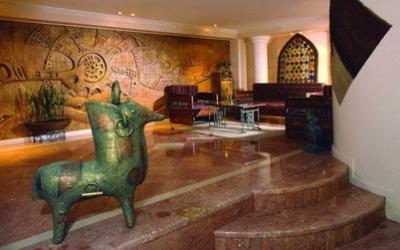
Hotel Melal

Hotel Niloo

Jamm Apartment Hotel
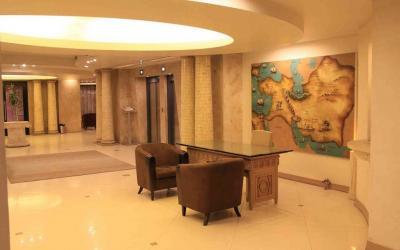
Sepehr Apartment Hotel

Tehran Grand Hotel
Other Hotels:
Parsian Azadi Hotel ![]()
Parsian Esteghlal International Hotel ![]()
Ferdowsi Int. Grand Hotel ![]()
Taj Mahal Hotel ![]()

